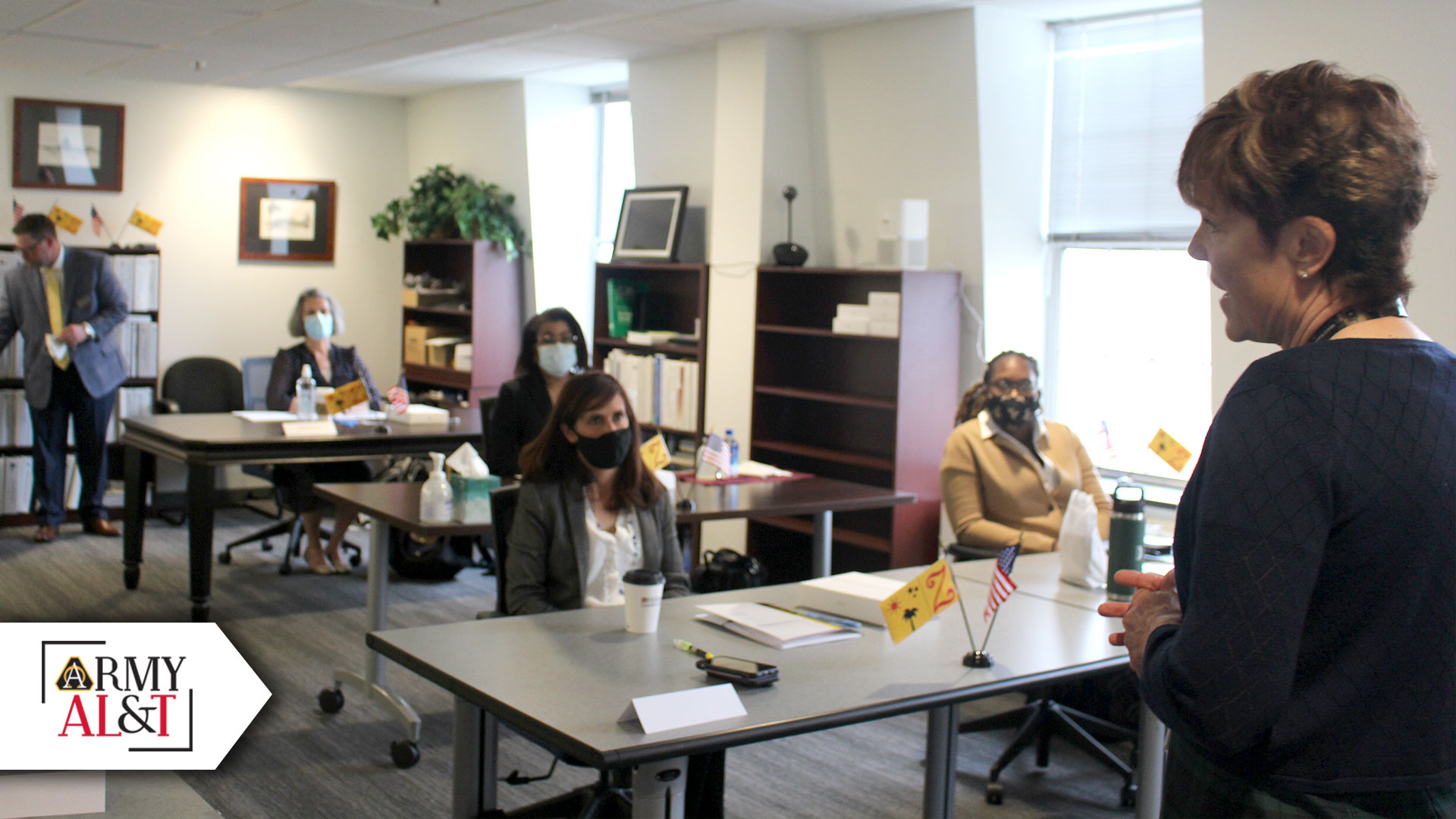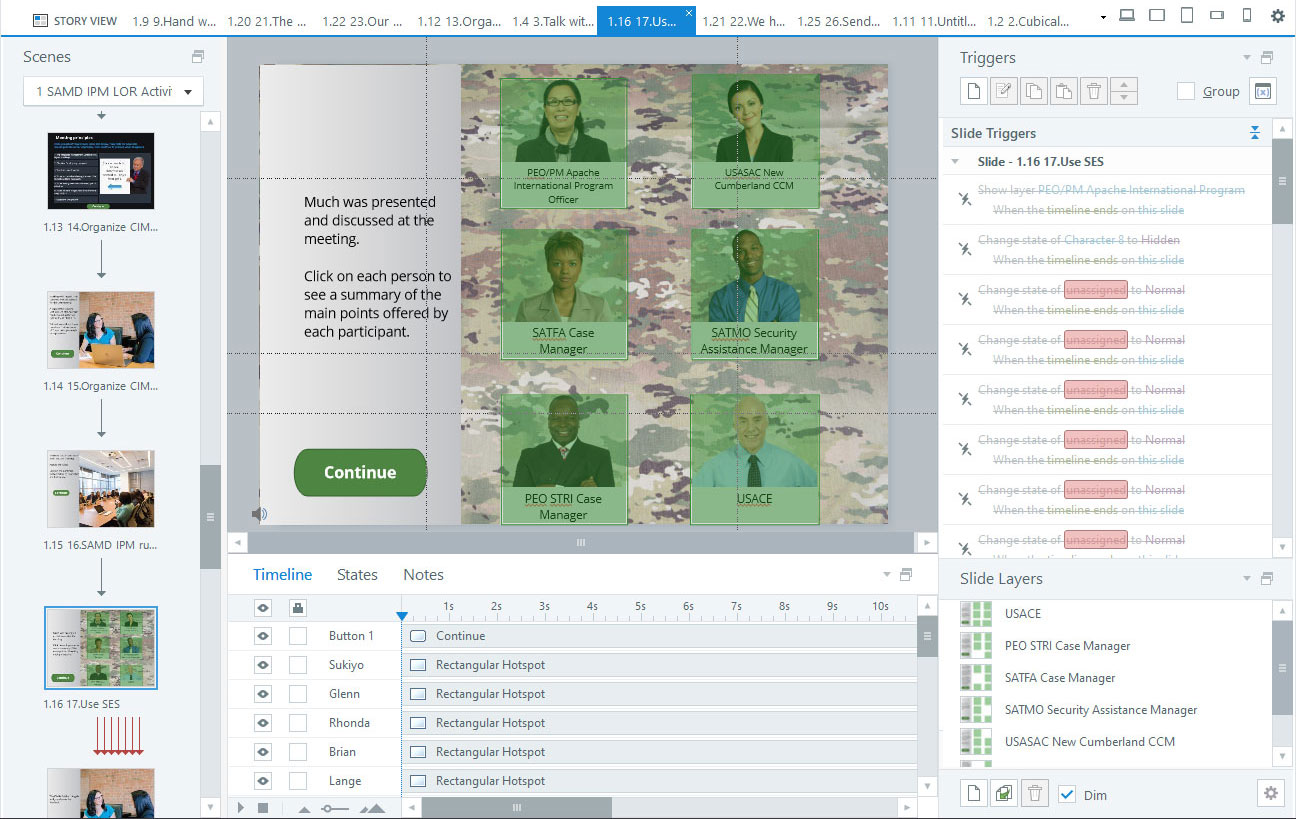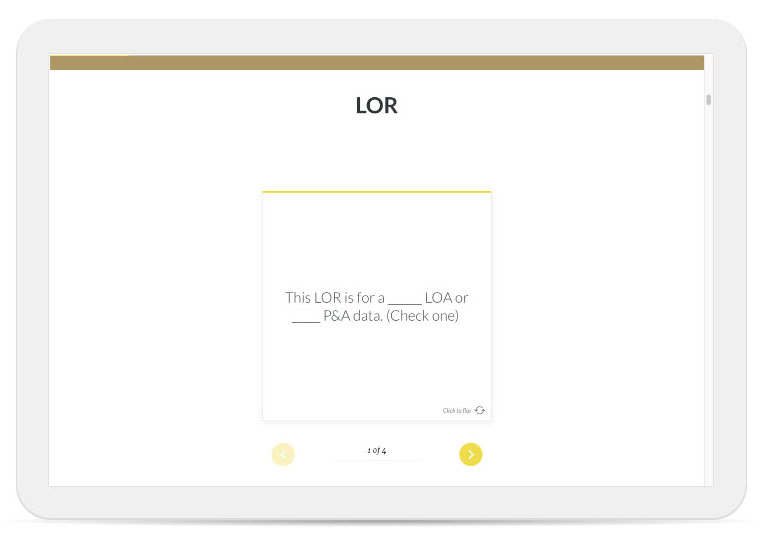
BETA TESTING: Elizabeth Wilson, DASA (DE&C), addresses the students in the beta session of the instructor-led training portion of the Army security cooperation enterprise course. (Photo by Cathy VanderMaarel, DASA (DE&C))
New, immersive educational course teaches foreign military sales for the Army security assistance enterprise workforce.
by Leslie Gordnier and Cathy VanderMaarel
A new training course explores Army roles in foreign military sales and related functions while seeking to fit the requirements of the multigenerational workforce–which has many different traits, needs and learning styles–and to overcome traditional barriers to learning as well as those brought on by COVID-19 restrictions.
The Office of the Deputy Assistant Secretary of the Army for Defense Exports and Cooperation (DASA (DE&C)) Security Cooperation Workforce Development Team has been working with subject matter experts to provide interactive and collaborative training to the Army security assistance enterprise. While Defense Security Cooperation University courses provide information to assist all personnel in the joint environment, the new course specifically addresses the Army’s roles.
The online portion of the course overcomes the generational and motivation hurdles by engaging and inspiring participants with topics relevant to everyday scenarios. It gives students the opportunity to immerse themselves in the subject matter, rather than only reading or following a slideshow.
The Army security assistance enterprise instructor-led training phase employs a unique strategy for educating the audience on the programs, processes and tools in export control and regulatory systems. The curriculum presents current policies and procedures to ensure participants understand—and are able to effectively implement—the many programs available to our foreign partners.

SAFE TRAINING: Dr. Juanita Stewart and Catherine Dakin, both from the Office of the DASA (DE&C), take part in coursework during the beta session of the instructor-led training portion of the Army security cooperation enterprise course. (Photo by Cathy VanderMaarel, DASA (DE&C))
COMPUTER-BASED TRAINING
DASA (DE&C) wanted to ensure that before registering for an in-person course, cohorts were presented with basic knowledge of foreign military sales and procedures, the associated agencies and organizations involved, the varied Army lingo and a multitude of acronyms used throughout the enterprise. This spurred the development of the computer-based training portion of the course. The 90-minute session serves as a prerequisite to the five-day instructor-led phase and is designed to provide foundational knowledge of the content.
The computer-based training modules were developed using HTML code, which provides a structure to take advantage of the breadth of web browser capabilities. Rather than a plain text document or the limited graphics capabilities of slideshows, HTML allows for embedded videos, click-through material presentation and other interactivity. Each module functions like a webpage with content distributed in vertically oriented segments along the Y-axis of the page, as is expected by internet users. By longitudinally orienting content, designers were able to employ explorative learning models that can be navigated via scrolling to reduce the number of clicks required by the user.
An added benefit of HTML-based modules was the ability to design courseware that could operate on a wide range of devices, such as computers, phones and tablets. This flexibility improved user access to the training material and enabled low-cost tablets to be used in the instructor-led training phase, instead of more expensive laptops. Bringing personally managed technology to the classroom gives students of different generations the ability to explore on the device with which they’re most comfortable.
The team applied three-step iterative prototyping to build, test and improve each lesson module to ensure the content was built properly. An interactive prototype was created first to demonstrate the general functionality and content flow of a single lesson. Once approved, the prototype was used as a model to develop an alpha version of the course, including a fully interactive module. As a final quality assurance step, the team delivered a content-complete beta version of the course for validation testing among a small cohort of representative users.

A TRIAL SIMULATION: David Williams, from the Office of the DASA (DE&C), and Melvin Porter, from the Security Assistance Training Field Activity, participate in a simulation portion of the beta session of the instructor-led training portion of the Army security cooperation enterprise course. (Photo by Cathy VanderMaarel, DASA (DE&C))
INSTRUCTOR-LED TRAINING
The Army provided to defense contractors the time and funding to conduct a thorough assessment of the material this course should provide. Fairchild Fisk Giroux LLC, the security assistance education and consulting firm selected to develop and lead the training, conducted several site visits and virtual meetings attended by dozens of personnel working throughout the Army security assistance enterprise. This included personnel at DASA (DE&C), U.S. Army Security Assistance Command, U.S. Army Aviation and Missile Command, U.S. Army Corps of Engineers, U.S. Army Training and Doctrine Command and individual enterprise organizations. In addition to detailed explanations for how the Army security cooperation process works, the Fairchild Fisk Giroux team gained insight on how critical it is, especially for new personnel, to gain an understanding of the roles of others in the enterprise.
Traditional training models—slideshow briefings, recitation and the like—are not reaching the training audience as effectively as they once did. Those models provide enormous amounts of content but fall short of delivering it seamlessly to audiences in the Information Age. The instructor-led course provides a new forum that brings experts on board and provides the most relevant information to the foreign military sales training audience. The course was designed to prevent cognitive overload when conducting facilitated instructional training with digital learning content. The content is deliberately delivered in smaller doses with only a few tasks required in each learning module and continuously aligns with foreign military sales goals and objectives, rather than having all content provided before a final examination or simulation.
The security assistance enterprise instructor-led course pairs updated, complex content and expert resources to transform the topics of foreign military sales and processes into engaging, visually creative and exciting lessons. There is a strong focus on visual content to improve knowledge retention. According to research presented in the British Journal of Developmental Psychology article “The Development of the Picture-Superiority Effect,” people only retain about 10 percent of information presented verbally. When they see an image, however, they remember up to 65 percent of the material. This phenomenon is called the pictorial superiority effect.
Adults learn best by doing. This course is fairly unique in the number of hands-on exercises and immersive experiences integrated with traditional instructor-led training. For example, there are a number of computer-based simulations in the course for students to complete, in which the student plays the role of a new country program manager. In that role, the student learns the responsibilities associated with that position; then through shadowing others in the Army security assistance enterprise, learns the duties of their respective positions. Students have said these are fun, engaging and effective learning experiences. “It’s nice to have an iPad assigned instead of a bunch of books, and to be able to take it with us at the end of the day,” said Dr. Juanita Stewart, DASA DE&C senior IT systems analyst lead and member of the beta testing session of the instructor-led training portion of the course. “It shows this course is up to date. Taking part in the [student-enacted] vignette helped me retain the information on how countries interact with each other in security assistance and cooperation.”

A CAST OF CHARACTERS: An interactive simulator allows students to choose which character they would like to click on to learn more information. This simulates the learning-by-doing instructional design technique for adult learners. (Image courtesy of DASA (DE&C))
The Army security assistance enterprise course adds an extra motivational touch to the training incentive, because experience has shown that when students receive an official qualification or certificate at the end of a course, they become more engaged in the training and retain more of the content. Each phase of the course will count individually as continuing education credit for security cooperation workforce certification.
CONCLUSION
Upcoming iterations of the course will continue to develop and train members of the enterprise. DASA (DE&C) is on track to lead the development of future training, creating new courses to take on the complex and specific regulated procedures within the foreign military sales arena, to educate the Army workforce and ensure best practices are shared.

TRAINING IN YOUR OWN HANDS: Students can access the course on a number of devices, including tablets, smartphones and laptops. Shown here, an interactive flip card simulation makes use of the tactile nature of a tablet. (Image courtesy of DASA (DE&C))
The Security Cooperation Workforce Certification Program was featured in an issue of Army AL&T magazine in 2020; the article can be found at https://asc.army.mil/web/news-security-cooperation-goes-pro/. Be sure to check the updates to the program provided in a link on that page as well. For more information, to register for a course or to learn how to bring Army security assistance enterprise training to a classroom near you, contact Leslie Gordnier at leslie.a.gordnier.civ@mail.mil.
LESLIE A. GORDNIER serves as the lead in Army security cooperation workforce development for security assistance enterprise training and has over 23 years in the joint service arena. She holds an Executive MBA from Auburn University Montgomery and a B.A. in history from Mount Saint Mary College. She serves concurrently as an Air Force Reservist in a special duty assignment as a first sergeant and is a two-time combat veteran and Bronze Star recipient.
CATHY VANDERMAAREL is a career Army public affairs civilian, having started in the field in 2003. She has served as a public affairs strategist at DASA (DE&C) since March 2020. She holds a Master of Public Administration from Norwich University and a B.A. in communications from the University of South Carolina. She has completed the training requirements for the Intermediate Level Security Cooperation Workforce Certification in the Security Cooperation Execution Support Area of Concentration.







